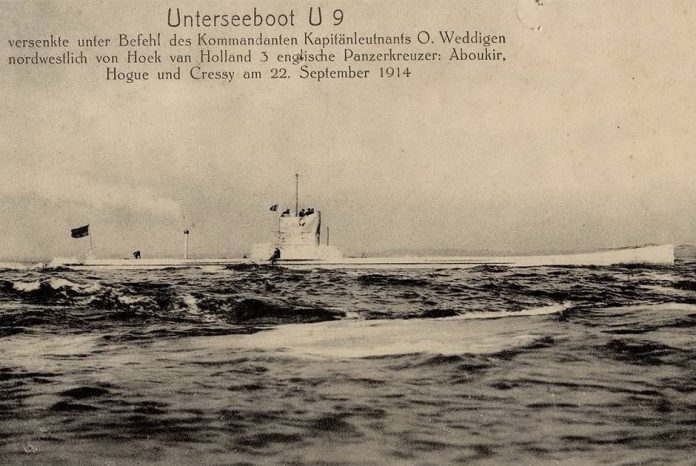
Did, and at the end 19 - early 20 centuries, more than one novel has been written about, what will the world war be like. Yes, they were somewhat fantastic, but the authors tried to foresee in them something, what will start. more precisely, what started after some 10 years.
I don't mean treatises on strategy and tactics, and semi-fantasy novels. Scrolled through a few, Takman, Julie and Junger, and I realized, that people at the beginning of the last century had absolutely no idea of that nightmare, which will take place on the battlefields.
Everything turned out to be wrong. The cavalry lost to machine guns, the infantry generally turned out to be a consumable in the games with artillery and gases, giants zeppelins, bringing death to cities, lost to biplane rattles, made of planks and ropes. Even tanks, which no one knew about at all, did not turn out to be something so imbalanced.
But no one, even in a terrible unscientific fantasy dream, could not imagine that, what will happen at sea. It is precisely on the seas of battles, not in the fields, progress hung as much as possible on conservatism.
You can talk a lot about the battles of the First World War, many still discuss Jutland, last (yes, in principle, and the first) large-scale battle of the giants, but now we're not talking about her.
Developments, about which you want to talk and speculate, were not so epic, like Jutland, but in my opinion had such an impact on military technology, that next to them you can put, perhaps, not much from military history.
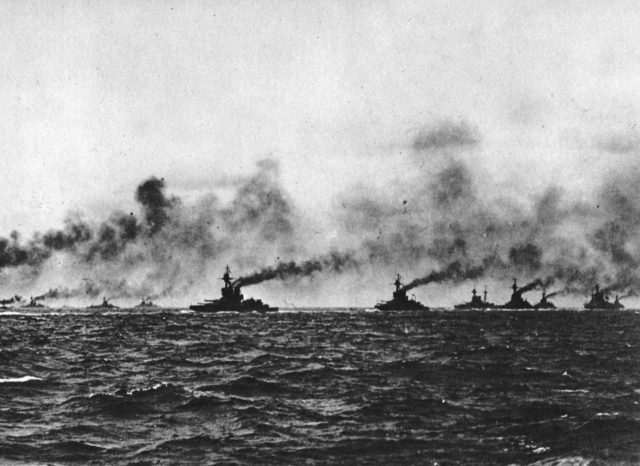
We are talking about ... a battle to call it the language does not turn. The battle is the Dogger Bank, this is Jutland, this is when two sides are at war. Damaging each other and so on.
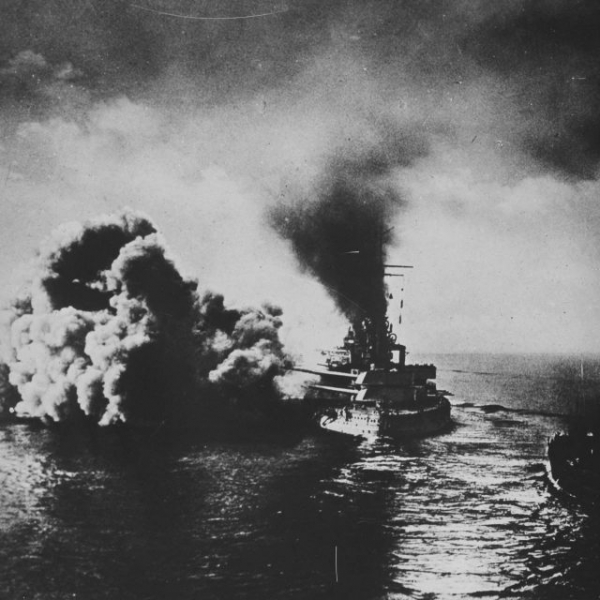
And we will talk about beating. Perhaps, this word is most suitable.
Everything happened 22 September 1914 years in the North Sea in 18 miles off the coast of Holland. Event, the essence of which was not only the humiliation of Britain as a maritime power, although this was the case, for in an hour Britain has lost more personnel, than the Battle of Trafalgar, but also the birth of a new class of combat vehicles.
Everything has been realized, that we are talking about submarines and carnage, arranged by Otto Weddigen with the crew of his U-9.
Three armored cruisers, "Hog", "Cressy" and "Abukir", could not oppose anything to the German submarine and simply drowned as a result of the very well-aimed shooting of the German crew.
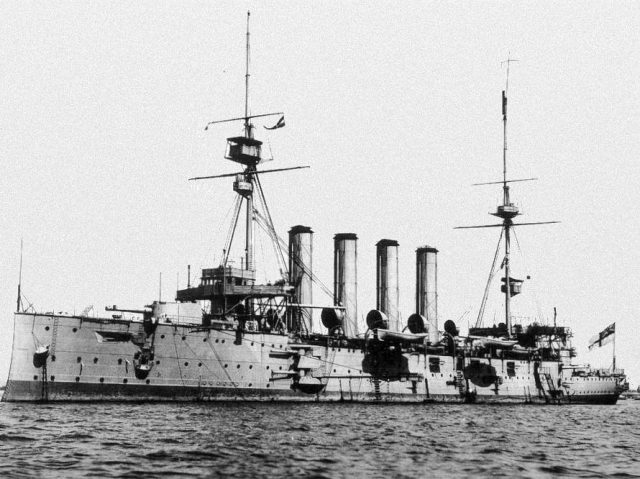 «Cressy». The entire series was named after him..
«Cressy». The entire series was named after him..
Submarines. Although at the time it would be correct to call them diving, because they could be under water very little in time.
There is something in any submarine ... Probably, understanding that, that today she can dive, and surface a thousand kilometers tomorrow. Or not to surface, which also happens.
But if we're talking about the First World War, then TE submarines - it was something. Real weapon of suicide bombers, perfectly understanding, what if anything - don't wait for salvation. Aviators, piloting strange rattles, at least there were primitive, but parachutes. The submariners had nothing, before the invention of scuba gear there was still 50 years.
So at the time the First World War began, the submarines were toys.. Expensive and dangerous, because the technologies of that time - you yourself understand, it's something. No normal diesels, no batteries, no air regeneration systems - nothing.
Respectively, and the attitude towards them was like that ... Marine penal battalion. Misbehave (very bad) - we will send to the "kerosene stove".
Before WWI, in previous wars, submarines did not show themselves at all. In the Russo-Japanese War, no Russians, no Japanese submarines did absolutely anything. Therefore, their effective as a weapon was considered negligible..
The British felt about the same.. "Vile and damn not British weapon" - such was the opinion of one of the British admirals.
The Germans looked at submarines in exactly the same way.. Furthermore, the great von Tirpitz himself did not want to finance the construction of these ships, which he considered completely useless. AND, generally, Germany entered the war, having in the fleet 28 submarines. The British had twice as many of them - 59.
What is a submarine of that time?
At all, they developed by leaps and bounds.
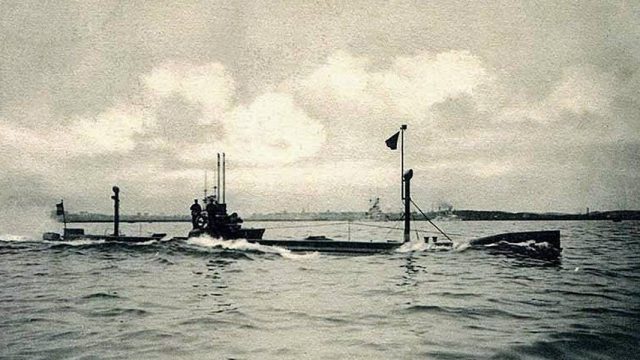 Submarine U-1
Submarine U-1
Judge for yourself: U1 had a displacement 238 tons surface and 283 tons underwater, length - 42,3 m, width - 3,75, sediment - 3,17. Two gasoline engines for surface running in 400 HP. and two electric motors for driving underwater.
The boat could reach speed 10,8 knot on water and 8,7 node under water and dive as much as 30 m. The power reserve was 1500 miles, which is generally very good, but the weapons are rather weak: one bow torpedo tube and three torpedoes. But then they did not know how to reload the torpedo tube in a submerged position. The hero of our story was the first to do this..
Artillery? Machine guns? Well, after all, the beginning of the century in the yard ... There was nothing.
But this 1904 year. But let's look at the boat of the hero of our story, Veddigena, U-9. Six years later, the boat was already somewhat larger.
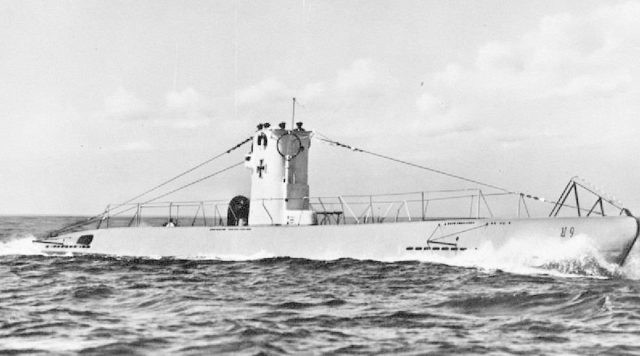
U9 joined the fleet with these parameters: displacement - 493 (above water)/611 (underwater) tonnes, length - 57,38 m, width - 6,00, sediment - 3,15, immersion depth - 50 m, speed - 14,2/8,1 host, power reserve - 3000 miles.
Gasoline engines replaced with two Korting kerosene engines (on the surface) and two electric motors under water.
But the weapons were quite: 4 torpedo tubes with ammunition 6 torpedoes and deck gun (retractable) caliber 105 mm. According to the staffing table, the crew consisted of 35 human.
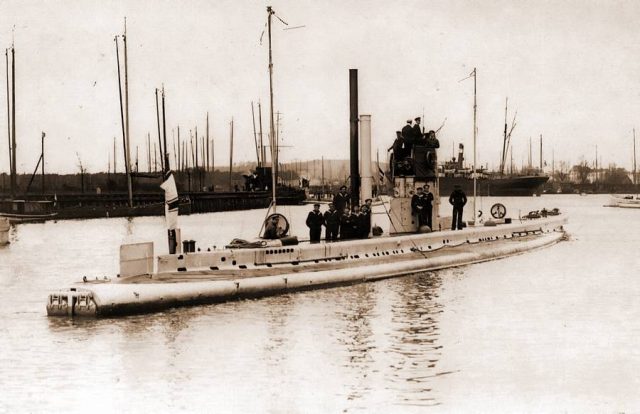
Well, the crews were preparing from the heart. The survivors later wrote about this in their memoirs..
But in Germany, as, however, and in the UK, in France and in Russia, were convinced, that the fate of a future war at sea will be decided by huge armored ships, armed with long-range artillery of the highest possible caliber.
Basically, that's how it started, but then the time came for what? Correctly, in Britain they decided to blockade Germany and lock her "High Seas Fleet" in the bases.
This was done by proven means, that is, with the help of all the same dreadnoughts / battleships and other ships such as battle cruisers and destroyers. British sailors had experience of similar operations, so they were able to organize the blockade very efficiently. So, that no German ship could slip by unnoticed.
Ship, but we are talking about boats ... Diving ...
So this blockade did not concern the submarines at all.. AND, running a little ahead, I will say, that during World War II German submariners gave the British a very serious headache with their actions. And already Britain was on the verge of a complete blockade.
But in World War I, the goal of the German submariners was primarily not the British merchant fleet., and the military. The blockade had to be lifted.
It happened, that one of the units of the British ships, blockading the Dutch coast, was composed of five large armored cruisers of the "Cressy" class.
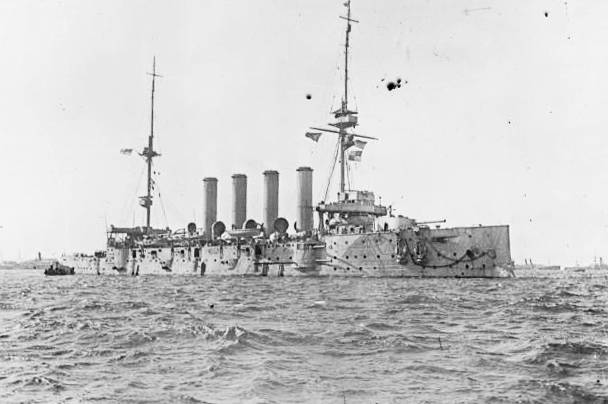
One side, blockade is an energy-intensive thing and requires a lot of ships. On the other hand, you shouldn't write off the weather.. Light cruisers and destroyers, of course, more suitable for such tasks, but the trouble is - great excitement nullified all the effectiveness of these ships.
That is why heavy, but seaworthy Cressy type irons could be on patrol in any weather, unlike destroyers. clear, that the British Admiralty did not create illusions about the fate of battleships, if they meet new German ships. Everything was clear and understandable here.
The group even received the nickname "bait squadron" (live bait squadron). And it was supposed to catch the ships of "Hochseeflot". And then already pile on them with all the ships of the main forces.
But these ships were definitely not "boys to fight". We look at the characteristics.
Type "Cressy". They were built not so long ago, in the interval from 1898 by 1902 years. Displacement 12 000 tonnes, slightly fewer battleships, but here's what there is a little.
Length - 143,9 m, width - 21,2, sediment - 7,6. Two steam machines (30 boilers) developed capacity in 21 thousand horsepower and speed up to 21 host.
weaponry: 2 guns caliber 233 mm, 12 x 152-mm, 14 x 76-mm, 18 x 37-mm. A plus 2 torpedo tubes. Armor belt thickness - 152 millimeter. The team consisted of 760 human.
Generally, such a five could puzzle anyone, with the exception of, probably, guys like "Von der Tanna" with comrades.
So what happened next?
And then a storm began in the patrolled sector. And the British destroyers were forced to leave their heavy cruisers and go to base..
It was generally considered in theory, that with such excitement, submarines cannot work, short and high wave will interfere. But nonetheless, cruisers had to navigate variable courses at a speed of at least 12 knots.
But two things happened at once. The first - and one, and another rule the British disregarded. And walked along the sector in a straight course at a speed 8 knots. Coal, apparently, care. Second - Weddigen did not know, that with such excitement, his boat cannot attack enemy ships. Because I went out to sea.
true, U-9 got it from excitement too. The boat lost its course and miraculously did not run aground due to a breakdown of the gyrocompass. But 22 September 1914 the sea has calmed down, and the weather was very good.
Seeing the smoke on the horizon, on the U-9 they turned off the engines and sank to periscope depth. Soon, the Germans saw and identified three British cruisers, walking two miles apart. Calculating the course, speed and probability of deflection, Weddigen fired the first torpedo with 500 m, can say, point blank. Across 31 a second the boat shook: the torpedo hit the target.
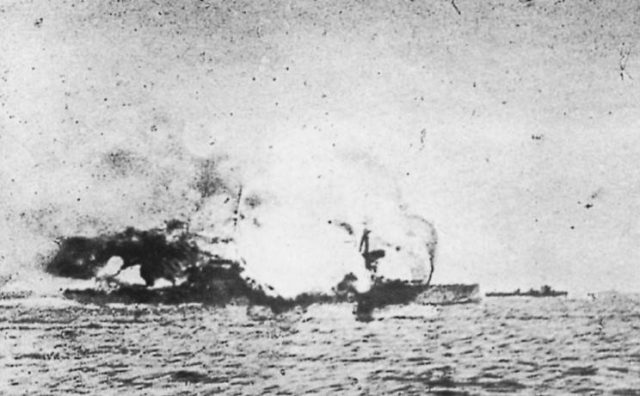
It was "Abukir". Command, "Yawned" torpedo, considered, that the ship was the victim of an unknown minefield. The cruiser began to roll to starboard. When the roll has reached 20 degrees, an attempt was made to straighten the ship, flooding opposite compartments, what didn't help, but only hastened the death.
Hog according to instructions, went to "Abukir", stopped the course in two cables and lowered the boats. When the boats rolled off the side, two torpedoes crashed into a stopped cruiser at once, and from the left side, a submarine suddenly flew to the surface of the sea.
While on "Abukir" they were thinking, what happened and fought for survivability, Weddigen managed to reload the torpedo tube and walked around the "Abukir" under water. And I ended up two cables from the Hog. U-9 fired a volley with two torpedoes and began to go deep and work out with engines back. But this maneuver was not enough, and the boat, healthy nose, went up. They still did not know how to compensate for the weight of torpedoes..
But Weddigen was really a tough commander and was able to level the boat., making free team members run inside, using people as moving ballast. Even in a modern submarine, it will still be an exercise., and in a submarine from the beginning of the last century ...
Generally, everything went a little out of plan, and it turned out like this, that the roll was leveled, but the boat was on the surface. According to the law of meanness, some three hundred meters from the "Hog". Yes, cruiser, cooked with two torpedoes, tonul, but it was a British cruiser. With British sailors on board.
Therefore it is not surprising, what with the "Hog", which remained on an even keel, opened fire on the boat. After a while, the boat went under water. The British were confident, that she sank. But the same law of meanness worked, and not a single shell hit the target. It's just that the Germans were still able to fill the ballast tanks and go to the depth..
"Abukir" by that time had already turned over and sank, almost immediately the Hog sank. On U-9, the batteries are almost empty, there was nothing to breathe, but Weddigen and his team, going into a rage, decided to attack the last cruiser.
Turning stern to the target, the Germans fired two torpedoes from a distance, the same 2 cable from their rear pipes. That is, again point blank. But on "Cressy" they already understood, what are they dealing with a submarine, and still spotted a torpedo trail. The cruiser tried to dodge, and one torpedo even passed by, but the second one hit the starboard side. The damage was not fatal, the ship remained on an even keel, and his guns opened fire on that place, where the boat was supposedly located. And with the same success, as "Hog".
And Veddigen still had one more torpedo and a mountain of unspent adrenaline. The Germans reloaded the torpedo tube for the second time in the battle, which in itself was not a feat, not that achievement. U-9 bypassed Cressy at 10 meters depth, climbed to periscope depth and hit the last torpedo on the left side of the cruiser.
And that is all. Being a good commander, Weddigen did not wait for the return of British destroyers, and with maximum speed rushed towards the base.
In this ... battle? rather, in this carnage Britain lost 1459 sailors, which is almost three times more, than in the Battle of Trafalgar.
The funny thing, what Weddigen believed, what attacks Birmingham-class light cruisers. Only after arriving at the base, submariners found out, that sent three heavy armored cruisers with a displacement of 36 000 tonnes.
When 23 September U-9 came to Wilhelmshaven, all of Germany already knew, what happened. Otto Weddigen was awarded the Iron Crosses of the first and second classes, and the whole crew - with Iron Crosses of the second class.
In Britain, the loss of three large warships caused shock. Admiralty, always reluctant to believe the obvious, insisted, that several submarines took part in the attack. And even when the details of the battle became known, the lords of the Admiralty stubbornly refused to recognize the skill of the German submariners.
The general opinion was expressed by the commander of the British submarine fleet Roger Keyes: «In the first months of the war, the sinking of surface ships by submarines was no more difficult, than ambush tame elephants, tied to trees».
However, the main outcome of the U-9 battle was not the sinking of three large cruisers., a grandiose demonstration of the capabilities of the submarine fleet.
Many then said, that Cressy-class cruisers were outdated, it was easy to sink them, but sorry, you might think, on the newest dreadnoughts or destroyers of that time, sonars were not yet installed, and even new ships were completely defenseless against submarines.
As for Germany, then the victory of U-9 gave her a powerful impetus to the development of the submarine fleet. The country rushed to build submarines. Until the end of the war, the Germans were commissioned 375 submarines of seven different types.
At all, after the Battle of Jutland and the subsequent complete blockade of German bases by the ships of the British fleet, submarines became the only effective weapon of warfare at sea.
During the First World War, British shipping from attacks by German submarines lost ships with a total cargo capacity 6 millions 692 thousand tons.
All in all 1914-1918 years, German submarines destroyed 5 708 vessels with carrying capacity 11 millions 18 thousand tons.
Plus is impossible to take into account, how many ships were killed by submarine mines.
During this time, the German submarine fleet lost 202 submarine, 515 officers and 4894 sailor. Every third submariner in Germany died.
Nevertheless, another new class of warships was born, which went through two world wars and many local wars. And today submarines are considered one of the most effective types of weapons..
funny, but once upon a time no one believed in "kerosene stoves" ...
/Roman Skomorokhov, topwar.ru/











